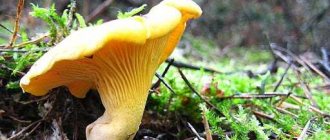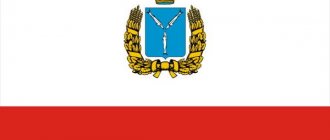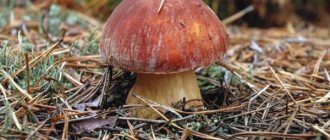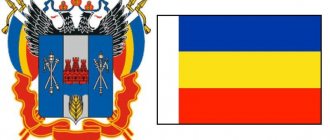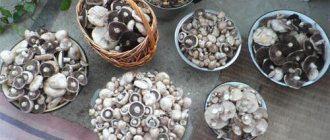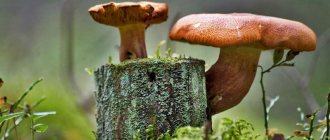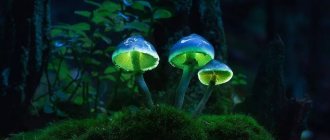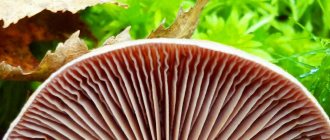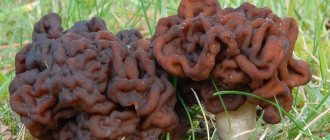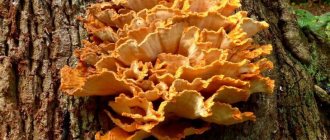Autumn mushroom picking
The climate of Crimea is characterized by its unpredictability. And it is difficult to predict when the mushroom season will begin. In one part of the peninsula they may not yet appear, but in another the “silent hunt” will already be in full swing. Crimean mushroom pickers know another feature of their region: mushrooms grow not only in the forest. Most of them grow in the steppes, preferring soil rich in organic matter. For example, the steppe single-barrel can be found right in the grass, in a clearing near a populated area.
The mushroom season lasts from very early spring to late autumn. But the fact remains that the snow has not yet had time to melt, and from under it the tiny heads of marsupial morels are already appearing. Puffballs and bigheads appear early.
Summer allows you to fully enjoy the rich variety of mushrooms. More than 100 species of mushrooms can be found in forest-steppe, steppe and forest areas. Mushroom professionals give preference to a few: mountain porcini mushroom, boletus, honey mushroom, saffron milk cap, aspen boletus, boletus mushroom and several more.
Until the very frost, the black and white (or gray) row is collected and eaten with appetite. It is also called little mice. Surprisingly, these mushrooms can be collected even a week before the winter holidays, just for the New Year's feast. And now more about the most favorite mushrooms of Crimea.
Mountain white mushroom
Crimean white mushroom
It has many names: giant pigwort, huge leusopaxillus. But the most accurate thing is the giant talker (Trichlomocha family). Prefers the soil of deciduous and coniferous forests. Found from early summer to mid-autumn.
Mountain porcini mushrooms grow in groups. If one is found under a birch or pine tree, there is a high probability that there are several more nearby. It's easy to spot them. The caps are large and fleshy (up to 20 cm in diameter). They can be completely white, but they also come in a pleasant coffee-with-milk color. If the mushroom is completely white, it means it is young and fresh. The hat should be smooth on top and covered with plates with bridges on the bottom.
The stem of a real white mountain mushroom is dense, but rather short, considering the size of the cap - only 3-8 cm. Closer to the cap, there may be villi on it. Sometimes a flour coating is observed. The leg is thickened from below.
The flesh of porcini mushrooms is also white, sometimes creamy. The smell is pleasant. It is described as mealy. Mature mushrooms may have a slightly bitter taste, so they are best used for drying. But in young mushrooms, the taste is more valued, and they contain more nutrients. One of them is the antibiotic clitocybin, which is harmful to the tuberculosis bacillus.
The mushroom can be confused with several other species. The smoky talker looks like him. It is often found in Crimean forests and is slightly inferior to mountain white in taste. It is more dangerous to encounter a poisonous gall mushroom. If you come across a whole clearing of whites, then you need to make sure whether this is a “witch’s” “ring”.
Crimean white mushroom is a welcome guest in every kitchen. It can be consumed stewed, salted, fried, baked or pickled. It can decorate and complement any dish with fried chicken, potatoes, or buckwheat porridge. You can’t list them all.
But mountain mushrooms cannot be stored for a long time. Immediately after collection, it is better to rinse them in cold water and leave them in salted water for half an hour. After cleaning the forest soil and leaves, the mushrooms should be kept in the refrigerator. No more than two days.
Mice (gray row)
Little mice or (gray row)
There are several types of rows that can be eaten. But they are quite difficult to distinguish from inedible ones. More often, mice are found in coniferous and mixed forests, in moss or on sandy soil. Rows can grow singly or in groups.
In Crimea they are found in early or mid-autumn. Experienced mushroom pickers go specifically for them to the forests near the village of Kolchugino or to the area of the Crimean Astrophysical Laboratory.
The hats of young mice (5-10 cm) have a conical shape with rolled edges. In mature rows it is flat, fleshy, with irregularities. The edges are unraveled and have small cracks. A small bump protrudes in the center. The plates in it are rare and widely spaced. The color of the cap is gray (from light to dark shade). After rain, it looks slimy and becomes slightly sticky, which causes leaves and small lumps of earth to stick to it, making it difficult to notice.
The stem of the row is dense, long (up to 12 mm), thickened at the base. In mature rows it becomes hollow inside. The color of the leg is pale yellow or grayish below. A plaque is visible next to the cap. The pulp of the mushroom has a dense but fragile structure with a faint powdery odor.
Mice can be salted, boiled, marinated. After boiling, they prefer to fry them and serve them as a tasty addition to main courses. Although they are very tasty in soups, casseroles, salads, and sauces.
Before cooking, they need to be sorted out, removing wormy mushrooms, dirt and pine needles. It is advisable to then soak for two hours in salted water with the addition of citric acid. If the mushrooms have a strong aroma, you can add a bay leaf or a couple of black peppercorns to the water to beat it off.
Mushroom places of Crimea
Large concentrations of mushrooms are found in the mountains. To do this you will have to rise approximately five thousand meters above sea level. Mushrooms grow on the sloping surfaces of the mountains. For example, you can harvest from:
- the western slopes of the Crimean mountains, where the Ai-Petri yayla with the famous peaks of Ai-Petri and Roka lies;
- Mount Demerdzhi is likely to find several types of mushrooms at once.
In the Crimean forests you can also find varieties of mushrooms, for example, near Alushta, where the village of Luchistoye is located, there are entire mushroom glades, just like in the area of the city of Sevastopol.
On the Crimean Peninsula, in many areas, various types of edible mushrooms grow, which are later used for food consumption. But poisonous specimens also grow here, and if you try them you can get poisoned. Therefore, when going for mushrooms, it is so important to know the characteristic differences between “good” and “bad” mushroom representatives.
0
0
Copy link
Chanterelles
Chanterelles or Cockerels
Another name is cockerels. The lands of the Simferopol region are rich in them. There are many of them near the village of Mramornoe. Mushroom pickers also go to the forests of Belogorsk, Kirov, and Bakhchisarai regions.
Chanterelles grow in numerous groups in sunny places, in clearings or next to clearings. They are also found in moss, among birches, pines, and spruces. Appear from the beginning of June. You can collect all summer until the first autumn frosts.
A distinctive feature of the structure: the mushroom does not have a pronounced transition from the stem to the cap. Uniform color: yellow (shades vary from light to dark, almost orange).
The hat has an irregular shape with wavy, unfolded edges that form a depression in the center. But its surface is absolutely smooth. The leg tapers downwards, the length is about 5 cm. The flesh is fleshy, dense, with a slightly sour taste. When pressed, it acquires a reddish tint. The smell is weak.
It must be distinguished from the false chanterelle, whose cap has no bends and resembles small funnels. In addition, their color is always orange, closer to red. The yellow hedgehog also looks like a chanterelle. This is an edible yellow mushroom. It has a fleshier cap and a thicker white stalk.
Chanterelles are very good for health. They help get rid of helminths, have a beneficial effect on liver cells (containing ergosterol in mushrooms), and are a source of vitamins. Increases the body's resistance to infections.
Chanterelles are easy to transport; they do not break when carried. You can cook it in any form. True, when fried they somewhat lose their taste. Pairs well with other mushrooms, such as porcini and boletus.
Autumn honey mushrooms
Autumn honey mushrooms in Crimea
Real autumn honey mushrooms are collected everywhere from the end of August to the end of autumn. These mushrooms almost never grow alone. They usually parasitize whole families on trees and stumps. Prefer moist soil.
In young honey mushrooms, the cap is concave inward, with growth it opens and becomes flat (size from 2 to 15 cm). The legs are long - up to 10 cm. The color of the caps and legs is the same - honey, but they have flake-like scales of a dark color, which is why honey mushrooms look brownish and slightly fluffy. There is a filmy ring under the cap.
False poisonous honey mushrooms have a gray-yellow color. The cap is whitish at the edges and has no scales. The pulp is light yellow with a bitter taste and earthy smell. The spore powder is brown, while in the autumn honey mushroom it is white.
Honey mushrooms can be prepared in different ways. It is better to boil peeled honey mushrooms in salted water for about five minutes. Be sure to then place them in a colander and allow the water to drain. Before serving, they are crushed, poured with sour cream or sprinkled with green onions. For pickling, cook for 20 minutes, after rinsing and removing dirt. After cooking, place in a glass container, add bay leaf, pepper, onion and dill. It is good to place mushrooms and additives in layers, one on top of the other.
What poisonous mushrooms in Crimea are most often confused with edible ones?
Among the poisonous Crimean mushrooms, the most dangerous are fly agarics, false honey mushrooms and toadstool.
Fly agarics
A poisonous mushroom can be identified by the following signs:
- bright orange-red or red cap with numerous white warts;
- there is a white or whitish-yellow ring on the stem;
- the base of the stalk is fused with a sac-like vagina and is also covered with warts.
This species of fly agaric does not smell of anything. Warts can be washed away by rain, which can cause the surface of the cap to become smooth.
False honey mushrooms
Sulfur-yellow honey mushrooms are characterized by the following features:
- a bell-shaped or outstretched cap of a sulfur-yellow hue with a darkening center and lighter edges;
- sulfur-yellow plates in young fruits;
- bitter pulp with an unpleasant odor.
Poisonous honey fungus is often mistaken for an edible species.
Death cap
The mushroom has the following features:
- presence of a ring;
- bag-like white volva around the base of the stalk;
- smooth surface of the cap and white plates that do not change color over time.
Pale toadstool is often confused with edible floaters, some russulas and mushrooms.
Common boletus
Common boletus
They are distributed everywhere, but there are especially many of them in the Belogorsk region of Crimea, in the village of Zelenogorskoye, as well as in Strogonovka and on the Ai-Petri plateau. Growing season: June – end of October. They love bright meadows and forest edges. Found in meadows. Insects like to eat boletus, so in the summer mushrooms are often simply eaten away by them. But by autumn the situation will normalize.
It is very difficult to confuse boletus with other mushrooms. Their name speaks for itself. The fleshy, juicy caps seem to be smeared with oil: they are slippery and slimy, brown or light brown in color. In mature butterflies, the caps open, taking on the shape of hemispheres. The older the mushroom, the higher the edges. The skin is easy to separate from the pulp. Under the cap there is a tubular layer with small yellow pores.
The legs are lighter than the cap, thin, up to 10 cm long. A white ring is clearly visible on a mature mushroom.
Butternuts cannot be stored for a long time, so after harvesting they must be cooked quickly. Before cooking (frying, boiling, canning), you need to remove the thick skin and sort them. All wormy mushrooms are thrown away. Then they are soaked for an hour in water with salt and completely cleaned of dirt.
Before marinating, they are boiled for 15-20 minutes. During cooking, you can add a little onion to the water, this will add piquancy to the future dish. Next, they need to be tipped into a colander and dried a little. Pickled in any way.
The boletus is frozen, boiled in water (cooking time - 5 minutes), dried and placed in small portions in plastic bags. After defrosting, butter mushrooms are stored for only a short time, so you only need to take out the required amount of mushrooms from the freezer.
Milk mushrooms
Pepper milk mushroom
Mushroom pickers come across mushroom pickers in mixed forests in the summer. Rarely found in the foothills and mountainous regions of Crimea. The main harvest season is July and September. Active growth begins after heavy rains.
There are no real milk mushrooms in Crimea, but oak, pepper and dry milk mushrooms grow. Pepper milkweed can be distinguished by its funnel-shaped white cap with grayish spots. On its narrow plates drops of milky juice are noticeable, which tastes very bitter. The leg is short, narrowed below. You can eat the mushroom after repeated soaking.
The dry milk mushroom also has a white cap, but with brown spots. The plates have a bluish color. The bitter juice does not appear after breaking. The mushroom is ideal for pickling and pickling (after pre-soaking).
In the mountainous part of Crimea you can find oak milk mushrooms. These reddish lamellar mushrooms grow in deciduous forests. Brown stripes are easily visible on their caps. Legs with yellow pits lose their density as they grow. Suitable for marinating, frying, boiling.
Saffron milk caps
Saffron milk caps
Appear in forests from July. They love shade and cool places under trees. They grow in large groups. In Crimea, their recognized place is Rybachye; they are also often found in the forests of the southern coast of Crimea.
The orange caps grow up to 12 cm in diameter. The bottom has reddish plates that turn green when pressed. the skin on them is a little sticky. The hollow legs, up to 2 cm thick, have dimples. The flesh of saffron milk caps is dense, sweet and has a fruity aroma.
Ryzhiki can be prepared in any way. They are salted very quickly: within two hours you get delicious salted mushrooms. The main thing is to add more spices.
Tips for mushroom pickers
Mushroom pickers have their own ethics of behavior, consisting of simple but very useful rules. For example, there is no need to kick mushrooms that are not of interest to you. Perhaps someone else will rip them off. For mushrooms, a basket made of twigs is best suited, since plastic bags do not allow air to pass through and, as a result, your collected “harvest” may not make it home.
You cannot break off the stems of the mushroom along with the mycelium, just as you cannot tear the moss. Under the sun's rays, the open mycelium will dry out and die. The most favorable conditions for the appearance of mushrooms are warm rain. That is, if there was a light rain in the evening, then in the morning you can safely go on a quiet hunt. Attention, the most important rule! If you're not sure, don't take the mushroom. At any slightest suspicion, it is better to just leave him in the forest. After all, life is much more important than the “harvest”.
What can be collected in Crimea.
Raincoats
Raincoat
Puffballs are mushrooms that cannot be poisoned. But when collecting them, you still need to check their flesh: in a real raincoat it is always white. Giant and pear-shaped raincoats are common in Crimea. The first has a fruit body that is round and white, but becomes yellowish over time. Can reach a height of 34 cm.
Also interesting to read: Poisonous mushrooms of Crimea
The fruiting body of the pear-shaped puffball is very similar in shape to a pear. The skin is rough with small tubercles. Raincoats grow in the foothills, choosing rotten wood for themselves.
Only young mushrooms are suitable for food. They are dried or fried. They also make a delicious mushroom soup. In terms of nutritional content they can be compared with white ones.
Edible mushrooms of Crimea or the last supper?
Edibility, beneficial properties and restrictions on consumption
Gray row belongs to category 4 edible mushrooms. It can be safely eaten only after high-quality heat treatment. Suitable for canning, salting and pickling, serushka can be eaten freshly prepared or dried.
Interesting!
After cooking, even ripe fruits, and not just young ones, fully retain their good taste.
The pulp of these mushrooms contains many vitamins, minerals and enzymes. In terms of their chemical composition and benefits, they are close to meat. Mice are recommended for consumption by those who suffer from diabetes and hypertension. They also normalize the functioning of the central nervous system and help cope with stress and fatigue.
Rows have a number of contraindications:
- age up to 10-12 years;
- allergy to the product;
- gastrointestinal diseases.

